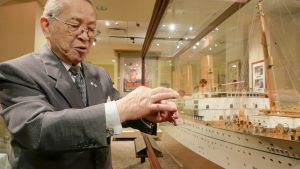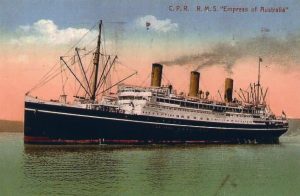

Situated on the lower flower floor of Irving Barber Learning Center, Rare Books and Special Collections of University of British Columbia, a giant ship model seats solemnly in the glass showcase. Under the lukewarm light, its white hull, large funnels and rounded stern appall any visitor by its delicacy upon entering the Chung Collection Exhibition Room.
The original ship, Empress of Asia, is said to be almost 600 feet long and could accommodate 1200 passengers in different tiers of compartment. From its maiden voyage in 1913 to last sail in 1942 when it was sunken by Japanese Navy during a British reinforcement to Singapore, it was recruited in both World Wars and performed military excellence with its fellow battleships.
Since its birth, this ship is closely bound with Asia. During First World War, 1937, it evacuated civilians in Shanghai during the Sino-Japanese War. While at peacetimes, it served as cargo freight or passenger cruiser linking Vancouver and some major Asian cities such as Shanghai, Yokohama, and Nagasaki.
The elderly who led the interviewers down to the exhibition room recalled, “It crosses from Hong Kong with three other Empresses, so there’s a ship leaving Vancouver every two weeks.” For him, this ship comprises another layer of emotional attachment—This is the ship with which his mother emigrated from China to Canada in 1919.
The elderly aforementioned is Dr. Wallace Chung, the former head of UBC Hospital’s Surgery Department, and also one of the vanguard Chinese Canadian doctors. To the interviewers however, he is more of a “collector” than a medical professional.
At the age of six or five, his father owned a tailor shop in Victoria Chinatown, partly because the immigration law exempted head tax for merchants. In the shop, a poster of a steamship hanging on the wall remains refreshing in his memory, as he remarked, “Steaming out of the sunset towards the new world. It indicates such a romantic type of story.”
The steamship was indeed Empress of Asia, also his initial inspiration to cut clips from newspapers, collecting photographs and other artifacts about Canadian cross-Pacific liners. This collection eventually turned into the Chung Collection in UBC today, to which he has continuously dedicated to donate from 1960 to 1999.
Some 40,000 items, including particulars like a bone mahjong set, a man’s head tax certificate, and a photo collage of a Chinese businessman’s family, collectively records a history of early Chinese immigration to Canada with hope, patience, and perseverance.
The collection was a result of a quandary: It was safely stationed in his house until his family decided to move into a condominium. Therefore, two options stood before him: to sell his collection or not. Dr. Chung elaborated on his pausing thoughts, “…I thought the collection—the picture, the model—tells an entire story. And you don’t want to break it up. So I decided to get all the literature, the models, the pictures, and donate [them] to the library here.”
Something as tangible as a model of his incipient inspiration was what Dr. Chung had been seeking for years. Until 1990, a woman, having accidentally seen a poster of early Chung Collection Exhibition at Vancouver Maritime Museum, informed him that its builders’ model was restored in a private condominium basement in Toronto, however, in a rather poor condition.
Dr. Chung recollected his first sight onto the model heartbrokenly, “It had been left for thirty years in an unheated garage…paint flaking, rusted, funnels broken, and pieces pulled off by children.”
Despite its serious dilapidation, Dr. Chung was determined to repair it completely. At first, he resorted to professionals but was told that the cost would be as high as 105,000 CAD. The price obstacle, however, did not deter him from pursuing the reparation. Instead, he decided to fix it by himself.
Dr. Chung began by finding references. He went to Scotland where the ship was built. In an antique store, he found the twelve-feet-long original builders’ plans with great details. Besides, whatever the plans could not specify, he would refer to his second source, the model of its sister ship, Empress of Russia, preserved at Vancouver Maritime Museum.
Even with these two handy references, the reparation was certainly no easy work. He adopted his dedication to medical precision to repairing the ship, which he demanded himself that everything pieced back to the model had to be handmade using the same materials and in the same manners as the original model builders had done before him.
To name a few details, the lifeboats, stolen by children when the model was found, had to be completely redone. Each lifeboat was made of fifty-seven tiny pieces that were hallowed from a square block of wood, curved into handles or paddles, and attached to each other piece by piece with Shishkabob stick glue.
Another toil was for the anchor. With both big chains missing, the anchor also had to be curved from another piece of wood. “…[Then] you get a piece of wire and around and around…and you cut one edge so each link drop out. You put the links together…[to] make a chain” As he spoke, Dr. Chung winded his hands around and around to show the interviewers how the work is done. And here is not to articulate on the also meticulously restored turnbuckles, stanchions, ladders, vents and funnels etc.
Fortunately, Dr. Chung was never alienated from work that requires extra precision. In several different interviews, he reiterated that his medical career helped him with repairing the ship, “Luckily, I have lots of micro instruments, surgical practice. So I was able to use them.” We felt privileged to look at his curving tools, some of which, especially the tweezers, knives, and magnifying lenses, are clearly for surgical purposes.
The reparation was eventually finished in 1991. The whole process proved to be arduous as well as time-consuming: It took him six years (1993-1999), accumulatively 4000 hours, according to his journals. In the same year, Dr. Chung added the model Empress of Asia together with more than 25,000 other artifacts to the Chung Collection at UBC.
In the dim-lighted exhibition room, through his face, I could tell that he started to immerse into numerous cherished memories. “[Night after night, a]bout eight or nine o’clock on, I start[ed] doing the model. I usually finish around right after midnight. But if it’s going very well and smoothly, and I’m not sleepy, sometimes I’ll go to two or three.” As I was pondering on such perseverance, his mother somehow caught my mind.
In 1915, his father went back to China and married his mother. His father wanted to bring his wife over, but the World War I happened. It was not until 1919 that Empress of Asia carried her to Canada, along with enormous other first Chinese immigrants.
Without the ship, all the rest story—the tailor shop, the poster, the collection and the model ship—would not have taken place. I wonder how great a variety of other family stories, some told while others yet to be, commenced at the exact moment when Empress of Asia set sail at sunset, leaving Hong Kong at faraway rearview—exactly as how it appeared on the poster that inspired Dr. Chung.
Suddenly, I understood and appreciated his perseverance better: It is about paying homage to the history of Canadian Chinese, and finding his places among them all.